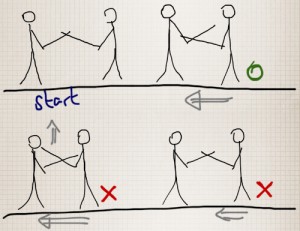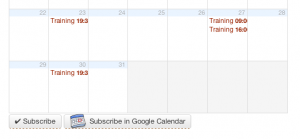Summary of class, 29/09Samenvatting les, 29/09
This summary is for the morning session in Almere.
After kata and warming up we proceeded with footwork practice. As part of balance exercises we did lunges.
- Hold your shinai across your belly with both hands, then lunge onto your right foot. Turn your upper body both left and right. Then lunge onto the left foot and repeat. Continue like this across the hall.
- Hold your shinai in normal kamae. Lunge onto right and strike men. Lunge onto left and strike men. Repeat across the hall.
- Hold your shinai across the back of your hips and do fumikomi across the hall. First singles, then doubles.
In all of these exercises, if you feel imbalanced and tend to wobble or keel over, then your footwork is too narrow. When lunging, keep your feet at kamae-width and sink deep. Hold a straight back.
After this followed laps of suriashi around the hall.
- The first four laps went fine: normal sliding steps, then variation in length and speed. Some people still put left past right, but most aren’t bad.
- The two/three fumikomi to reach the other side also went “okay”, though many show issues with both the right and the left feet (explained below).
- Charl suggested a shiai exercise: start with small suriashi, then make two/three big slides and then fumikomi with follow-through.
- Then finally, with continuous fumikomi across the hall things went to pieces completely. Everyone was bad.
Loyer-sensei and Kris-fukushou inform us that the problems are twofold. For one, most of us aren’t properly launching themselves with the left foot. Either we’re not kicking hard enough, or we’re kicking backwards after launching. Many of us also lift the right foot way too high when lunging forward. Not only does this clearly signal your intentions to your opponent, but it also slows you down. As Kris pointed out, many of us don’t stomp their right foot for forward speed but we come to a full stop because we kick downward or even forward.
While the beginners renewed their focus on kirikaeshi and kihon, we practiced a few waza.
- Hayai-men and hayai-kote-men. To keep the basics in there :)
- When doing harai-men you could say you’re doing a kote-men where the kote strike is actually a push over your opponent’sshinai. Keep your shinai on the center line (inside) and when moving inwards, smack his shinai aside and down to open your way to men. This is slightly similar to, but also completely different from the “special” move Heeren-sensei showed us last Tuesday.
- When doing harai-kote, keep your movements small. Make an elliptical path underneath motodachi‘s shinai and on the way up, smack the shinai upwards to the right. On the way down again strike his kote. Remember, the elipse needs to be very small!
- When doing kaeshi-do against a men strike, use the upswing towards your shoulder to guide motodachi’s shinai to the left. Then strike do while staying on the center line. Make it a proper strike! Don’t start moving to the right before you’ve connected properly.
When attacking, imagine your goal to be two meters behind your opponent! Don’t strike and immediately dash aside. Worse yet, don’t immediately turn towards him! Rush through them and if they get in the way, go into taiatari. Don’t hold your hands too high, as they’ll simply topple you. “Tsuba into the mouth“, as they say.
Finally, because tomorrow is a tournament day: the practice shiai! Because we don’t have much experience with tourneys we went over the basic etiquette. Both teams decide the order of kenshi, one through five (or three as is the case tomorrow). Only the first kenshi will be wearing his men from the start. The teams greet each other, then retreat to their side of the court. Everyone except the first sits down and pays attention to the fights. Numbers two and three will start putting on their men. Four and five will follow later. Then, each participant will continue as follows.
- Step into the shiaijo. Step to a position from which you can reach your starting line with three paces.
- Bow to your opponent.
- Three steps to your line, right foot on the line. Not over, not in front, on the line. In your steps, draw your shinai and go intosonkyo.
- Do not rise until the shinpan provide the command to “Hajime!“.
- Return to your line when a point has been made.
- If something is wrong, raise your hand. Both kenshi return to their line, while the shinpan find out what is up. If you need to disrobe, both kenshi step back and the other waits in sonkyo while you fix whatever is wrong.
- When the match has been won return to your line. Sonkyo and put your shinai away.
- Five steps back. Bow. Step out of the shiaijo backwards and take your seat.
The Nanseikan kendo dojo has a more complete article on the subject of shiai etiquette.Deze samenvatting is van de ochtendsessie van Almere.
Na kata en de warming up begonnen we met voetenwerk oefeningen. Om balans te oefenen deden we uitvallen (diep instappen met één voet en diep doorzakken).
- Houd je shinai horizontaal voor je buik en sta in kamae. Doe een uitval met rechts. Draai je bovenlijf nu naar rechts en links, maar houd je heupen stil. Doe nu vanuit deze diepe houding een uitval met links. Beweeg je bovenlijf weer naar rechts en links. herhaal tot aan het einde van de zaal.
- Houd je shinai normaal vast. Doe een uitval met rechts en sla men. Doe een uitval met links en sla men. Herhaal tot het einde van de zaal.
- Houd je shinai horizontaal in je rug, op je heupen. Doe nu fumikomi over de lengte van de zaal. Eerst enkel, daarna dubbel (kote-men voetenwerk).
Met al deze oefeningen geldt dat, als je onbalans voelt en wiebelig staat (of omvalt!), dan is je voetenwerk te smal. Bij de uitvallen moeten je voeten constant op schouderbreedte blijven. Het is niet de bedoeling dat je met een goede kamae begint om daarna steeds nauwer te worden. Houd je rug ook recht.
Hierna volgde rondjes suriashi rondom de zaal.
- De eerste vier rondes, regelmatige suriashi gevolgd door gevarieerde groottes in stappen, ging goed. Sommigen toonden wel problemen waarbij de linker voet toch voorbij rechts kwam.
- De rondes met twee/drie fumikomi (met suriashi voor en na) gingen ook redelijk, hoewel veel mensen al problemen tonen met de linker en rechter voeten (zie onder).
- Charl stelde nog een shiai-oefening voor: begin met kleine schuifels, maak dan twee/drie grote stappen, doe fumikomi en ga nog even door.
- Helaas viel het allemaal volledig uiteen bij de oefening met onafgebroken fumikomi rondom de zaal. Niemand deed het goed.
Loyer-sensei en Kris-fukushou zagen twee grote problemen bij ons aller voetenwerk. Allereerst gebruiken de meesten van ons de linker voet niet goed genoeg om af te zetten. Of we doen het niet hard genoeg, of we trappelen naar achter na het afzetten. Ten tweede tillen veel van ons de rechter voet veel te hoog op bij de uitval. Niet alleen verklapt dit je intentie aan je tegenstander, maar het vertraagt je ook. Zoals Kris zei: veel van ons stampen hun voet niet zodat ze snelheid naar voren maken, maar stampen recht naar beneden of naar voren waardoor we volledig stil vallen.
Terwijl de beginners bezig gingen met kihon en kirikaeshi, ging de rest waza oefenen.
- Hayai-men en hayai-kote-men. Basics blijven belangrijk :)
- Als je harai-men doet (niet hayai, maar harai), zou je kunnen zeggen dat je een kote-men doet waarbij de kote-slag een zet bovenop de shinai van je tegenstander is. Houd je eigen shinai op het midden terwijl je naar binnen stapt, geef zijn shinai een zetje naar links-onder en sla men. Het lijkt een beetje op de “special move” die Heeren-sensei ons dinsdag liet zien, maar is toch ook anders.
- Houd bij harai-kote je bewegingen klein. Maak een ei-vormige beweging onder motodachi’s shinai door. Bij de zwaai omhoog tik je zijn shinai naar rechts-boven waarna je direct doorgaat naar een slag op kote. De elipsvormige beweging moet erg klein zijn.
- Als je kaeshi-do doet tegen een men slag, gebruik dan de beweging van je shinai naar je schouder om motodachi’s shinai naar links te leiden. Sla do terwijl je netjes op het midden blijft. Maak het een goede slag!
Als je aanvalt, beeld je dan in dat je doel twee meter achter je tegenstander ligt. Spring niet meteen aan de kant na je slag, dat toont geen zanshin. Draai je niet meteen naar’m om. Ga door je tegenstander heen en als hij niet aan de kant gaat doe je taiatari. Houd je handen niet te hoog, want anders word je achterover gegooid.
Omdat morgen een toernooidag is hielden we een shiai en omdat we weinig ervaring hier mee hebben letten we extra op etiquette. Beide teams besluiten de volgorde van hun kenshi en groeten elkander. Alleen de eerste strijder draagt direct zijn men. Iedereen gaat zitten op zijn plaats en let op de gevechten die volgen. Spelers twee tot en met vijf zetten hun men op tijdens de wedstrijden van de anderen. Elke deelnemer doorloopt de volgende stappen:
- Stap de shiaijo in. Stap naar een een positie waar vandaan je jouw lijn binnen drie stappen kan bereiken.
- Buig naar je tegenstander.
- Neem drie passen tot jouw lijn, rechter voet op de lijn. Niet er over, niet er voor, er op. Trek tegelijkertijd je shinai en doe sonkyo.
- Sta niet op totdat de shinpan het commando “Hajime!” geven.
- Wanneer er een punt is gemaakt ga je terug naar jouw lijn.
- Als er iets mis is, steek je je hand op. Beide kenshi keren terug naar hun lijn, waar de shinpan uitvindt wat er aan de hand is. Als je je harnas moet herstellen, of als er iets ergers aan de hand is, stappen beide kenshi terug naar de rand van de shiaijo, waar de ander in sonkyo wacht.
- Keer terug naar je lijn als de wedstrijd is gewonnen. Sonkyo en berg je shinai op.
- Neem vijf stapjes achteruit. Buig. Stap achteruit de shaijo uit en neem je plaats aan de rand
De Nanseikan kendo dojo heeft een wat completer artikel over shiai etiquette.


